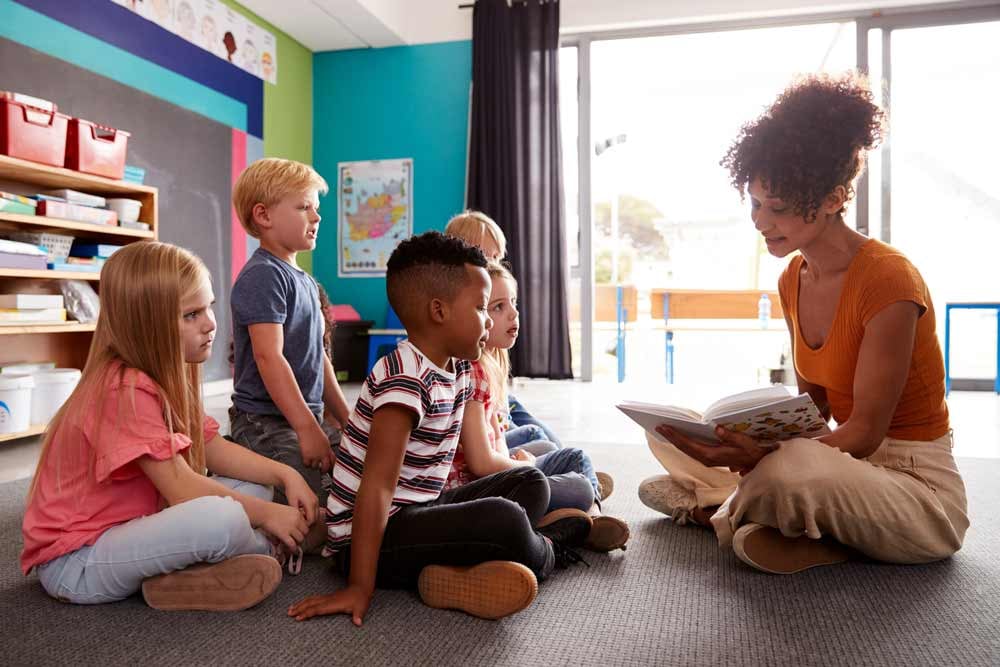
At Kid Spark Education, in our work providing STEM education early and consistently, we’re well aware that there are a variety of ways to bolster a love of STEM learning in the classroom. For elementary school students in particular, there are so many books that teach about science, technology, engineering, and math. From covering famous figures to opening up students' minds to STEM concepts, to serving as a good launching pad for in class activities— even storytime can be a STEM learning experience.
By making books available for students to see themselves as scientists and understand STEM concepts, students can be set up for success and a lifetime of STEM learning. With that in mind, we’ve compiled this list of some of our favorite books that are designed to bolster STEM in any elementary school classroom!
1. Math Curse by Jon Scieszka
As a children’s book that shows the connections of math to everyday life— from probability to fractions, to statistics and charts, every single moment in the book is a math problem. Reading the book aloud to elementary school students not only shows how STEM can play out in real life, but multiple math problems to work on in class.
After reading, you can brainstorm with students how they use math in everyday lives and even create activities surrounding math in their everyday lives. This will help turn that “math curse” into an engaging learning experience.
2. Calling All Minds By Temple Grandin
Written by world-renowned autism spokesperson, scientist, and inventor Temple Grandin, this book features stories, explanations, and questions about a variety of inventions. Reading this aloud to your elementary school classroom will allow children to imagine how engineering functions in the real world.
Featuring 25 projects for your classroom to try, you can try out these ideas in STEM labs and other STEM activities in your classroom. Whether you integrate these problems into exercises you already have planned or base a STEM activity on the book, you can teach a deeper understanding of scientific thinking while supporting divergent ways of thinking.
3. Luna's Yum Yum Dim Sum by Natasha Yim
Using the idea of splitting dumplings at Dim Sum equally, this story follows Luna as she problem solves with her brothers with fractions using both convergent and divergent learning. Using the problem of splitting up dumplings, you can run exercises within your own classroom to use math and collaboration to determine a solution.

Whether you use the concept of splitting dumplings or something else in your classroom, you can make the idea of fractions as something tasty and fun.
4. Someone Builds the Dream by Lisa Wheeler
There are all types of work in STEM that don’t necessarily involve being in a lab or working in a cubicle with lines of code. This book explores the work of building bridges, wind farms, agriculture, construction, and more. This book in particular is a great introduction to doing STEM labs like the ones at Kid Spark Education where students build bridges, entryways, ways to make things strong, and more.
The book is a great opportunity for students to talk about real landmarks made with STEM and the work their friends or family do in building the world they live in. This will help students make connections to how engineering and science work in the real world.
5. What to Do With a Box by Jane Yolen
As the book explores what can be done with a cardboard box, it is a great jumping off point to allow elementary school students to experiment building different structures. By giving students access to cardboard, the book can be used as an activity to see what students can build.
Especially as you move on to programming like Kid Spark Education STEM labs, this can help inspire students to learn to design and build with simple components to solve problems. For our Foundational Fluencies lab, students learn to make structures out of building components in our STEM labs. Introducing students to a component like a cardboard box to learn spatial reasoning, sequence, correspondence, and problem solving, will help them learn STEM concepts that much faster.
6. How to Code a Sandcastle by Josh Funk
Taking the concept of building a sandcastle, Pearl and her robot friend Pascal use coding concepts to build a frisbee-proof sandcastle. Featuring loops, variables, and sequences, elementary school classrooms can learn some of the basics of coding.

At Kid Spark Education, we have labs involving coding for older elementary school students and middle schoolers, so starting with a book like this can build a strong foundation for students to learn coding fundamentals. Starting out, students can figure out how to code their own sandcastle and build other structures with coding concepts.
7. The Most Magnificent Thing by Ashley Spires
In this book, we follow a young girl’s journey as she tries to make “the most magnificent thing”. From measuring to tinkering, brainstorming to missteps along the way, elementary school students can learn about the value of creativity and perseverance. Taking the book in context, students can brainstorm what they want to build and what problems they could solve along the way.
This book is a great introduction to the process of engineering and getting started with a lab like Kid Spark Education programming. By seeing the main character as an engineer and designer, students can start to see themselves as an engineer and designer themselves. This will help elementary school students have the confidence to author with technology.
8. A Computer Called Katherine: How Katherine Johnson Helped Put America on the Moon by Suzanne Slade
Telling the story of Katherine Johnson, whose story was featured in the film Hidden Figures, this book shows the importance of STEM ingenuity in our history. As your students learn how she worked on math equations and code, you can discuss how far coding has taken mankind and how it continues to evolve. This is also a great introduction into the type of coding done for running simple machines for students to experiment with.
Talking with students about Katherine Johnson and all the work she did to help put America on the moon, you can help them see the amazing results of creativity, perseverance, and dedication in STEM. It also is a great introduction to how science and coding works with engineering and design to solve problems. This will help students see the importance of science in history and what problems they could hope to solve in the future.
Need More Ways to Add STEM to Your Elementary School Classroom?
Of course, there are so many amazing books featuring STEM and historical figures you can start using in your classroom. This is just a jumping off point with some of our team’s favorite picks. In addition to reading materials, it’s important to have a full STEM program to support your students.
At Kid Spark Education, we help schools and educational service providers disrupt the pattern of educational inequity by providing STEM education early and consistently for Pre-K – 8th grade students. By giving kids of all backgrounds and abilities an equal chance to learn and love STEM, we are nurturing the next generation of successful professionals, bold thinkers, and passionate leaders. Our programs do this with progressive units of instruction that cover a range of STEM concepts, and can be used to meet any student where they are. In addition we offer STEM labs and professional learning for instructors. If you’re ready to try adding Kid Spark Education to your classroom, we’d be happy to talk to you further. For more information on bringing STEM labs to your elementary school, contact us today!
.png?width=1270&height=453&name=Copy%20of%20Kid%20Spark%20Logo%20(Horizontal%20-%20Full%20Color).png)